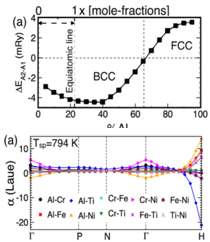
Multi-principal-element alloys, including near-equiatomic high-entropy alloys, experience partially-ordering or segregation as they are cooled. Our density-functional theory (DFT) based electronic-structure and SRO predictions supported by concentration-wave analysis are shown to be a powerful method for fast assessment of competing phases and their stability in multi-principal-element alloys. For Ti0.25CrFeNiAlx alloys, experiments suggest a partially-ordered B2 phase, whereas CALculation of PHAse Diagrams (CALPHAD) predicts a region of L21+B2 coexistence. We employ our first-principles DFT-based electronic-structure approach to assess stability of phases of alloys with arbitrary compositions and Bravais lattices. In addition, DFT-based linear-response theory is utilized to predict Warren-Cowley short-range order (SRO), revealing competing long-range ordered phases. The SRO theory is uniquely analyzed using concentration-waves theory for occupation probabilities in partially-ordered states, permitting direct DFT assessment of alloys with partial order. Our results are in good agreement with experiments and CALPHAD in Al-poor regions (x < 0.75) and with CALPHAD in Al-rich region (0.75 < x < 1), and suggest more careful experiments in Al-rich region are needed.
P. Singh, A.V. Smirnov, A. Alam, Duane. D. Johnson*, First-principles prediction of incipient order in arbitrary high-entropy alloys, Acta Materialia 189, 248-254 (2020). DOI: 10.1016/j.actamat.2020.02.063
See also joint thin-film experiments & theory: A. Marshal, P. Singh, et al., JALCOM (2020). DOI: 10.1016/j.jallcom.2020.155178
